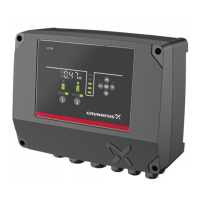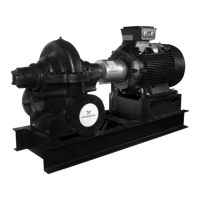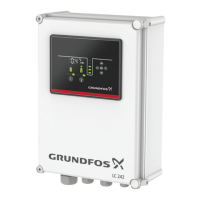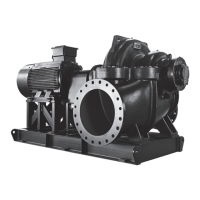5
English (US)
3. Receiving the product
3.1 Unpacking the product
3.2 Inspecting the product
• Check that the product received is in accordance with the
order.
• Check that the voltage, phase and frequency of the product
match the voltage, phase and frequency of the installation site.
See section 7.3 Pump identification.
• Check the product for defects and damage immediately after
receiving it. Any accessories ordered will be packed in a
separate container and shipped with the product.
• If any equipment is damaged in transit, promptly report this to
the carrier's agent. Make complete notations on the freight bill.
3.3 Temporary storage after delivery
• If the product is not to be installed and operated immediately
after receiving it, store it in a clean, dry area at a moderate
ambient temperature.
• Rotate the shaft by hand periodically, at least weekly, to coat
the bearing with lubricant to retard oxidation and corrosion.
• Follow the motor manufacturer's storage recommendations
where applicable.
4. Installing the product
4.1 Location
• Locate the pump as close as possible to the liquid supply. Use
the shortest and most direct inlet pipe practical. Refer to
4.4.2 Inlet pipe.
• Locate the pump below system level wherever possible. This
will facilitate priming, assure a steady liquid flow, and provide
a positive inlet pressure.
• The net positive suction head (NPSH) available must always
be equal to or exceed the required NPSH specified on the
pump performance curve. Make sure the required NPSH is
provided at the inlet.
• Always allow sufficient accessibility space for maintenance
and inspection. Provide a clearance of 24 in. (610 mm) with
ample head room for use of a hoist strong enough to lift the
product.
• Electrical characteristics must match those specified on the
motor nameplate, within the limits covered in section
5. Starting up the product.
• Do not expose the product to sub-zero temperatures to
prevent the pumped liquid from freezing. If there is frost during
shutdown periods, see sections 5. Starting up the product and
9.2 Short-time shutdown.
4.2 Pump foundation
• LF pumps must be grouted in order to ensure a stable pump
and motor shaft alignment.
• LCS pumps do not require grouting to maintain shaft
alignment, but grouting will increase pump stability within the
pipe system.
• LC and LCV pumps do not need to be grouted.
Install the pump permanently on a firm, raised concrete
foundation of sufficient size to dampen any vibration and prevent
any deflection or shaft misalignment. The foundation may float on
springs or be a raised part of the floor.
Proceed like this:
1. Pour the foundation without interruption to 0.75 - 1.5 in.
(20-35 mm) below the final pump level. Leave the top of the
foundation rough. Then clean and wet it down.
2. Scour and groove the top surface of the foundation before the
concrete sets to provide a suitable bonding surface for the
grout.
3. Place anchor bolts in pipe sleeves for positioning allowance.
See fig. 1.
4. Allow enough bolt length for grout, base flange, nuts, and
washers.
5. Allow the foundation to cure several days before proceeding
to install the pump.
WARNING
Overhead load
Death or serious personal injury.
- Do not lift the product by the eye bolts on the
motor.
Unload and handle the product with a sling.
LC_LCV_LF_LCS_1 language_US Eng.book Page 5 Thursday, August 24, 2017 4:08 PM

